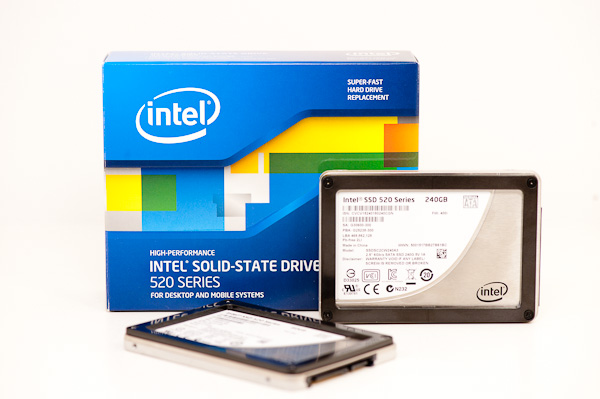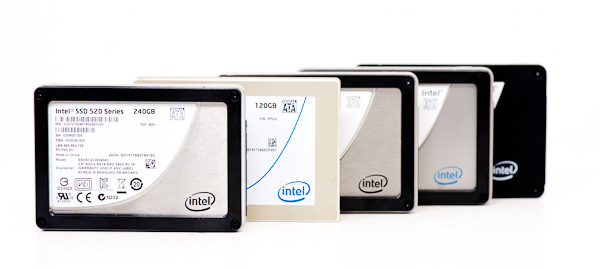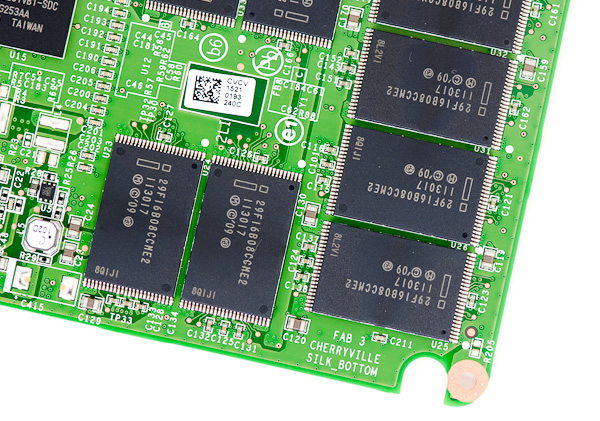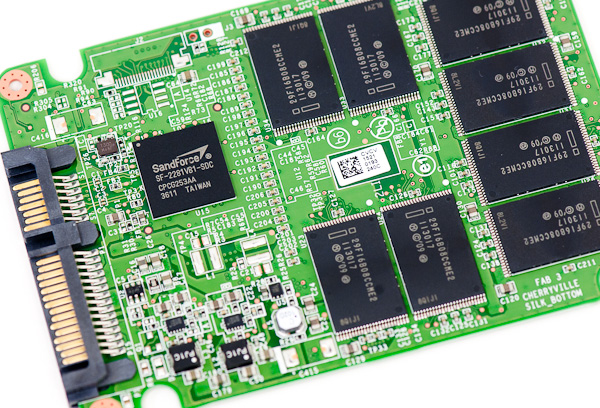Intel SSD 520 Review: Cherryville Brings Reliability to SandForce
by Anand Lal Shimpi on February 6, 2012 11:00 AM ESTIntel was rumored to be working on a SandForce based drive for several months now, but even the rumors couldn't encapsulate just how long Intel and SF has worked on this drive. According to Intel, the relationship began 1.5 years ago. Still lacking a 6Gbps controller of their own and wanting to remain competitive with the rest of the market, Intel approached SandForce about building a drive based on the (at the time) unreleased SF-2281 controller. Roughly six months later, initial testing and validation began on the drive. That's right, around the time that OCZ was previewing the first Vertex 3 Pro, Intel was just beginning its extensive validation process.
Codenamed Cherryville, Intel's SSD 520 would go through a full year of validation before Intel would sign off on the drive for release. In fact, it was some unresolved issues that cropped up during Intel's validation that pushed Cherryville back from the late 2011 release to today.
Intel's strenuous validation will eventually make SandForce's drives better for everyone, but for now the Cherryville firmware remains exclusive. Intel wouldn't go on record with details of its arrangement with SandForce, but from what I've managed to piece together the Intel Cherryville firmware is exclusive for a limited period of time. That exclusivity agreement likely expires sometime after the SF-2281 is replaced by a 3rd generation controller. There are some loopholes that allow SandForce to port bug fixes to general partner firmware but the specific terms aren't public information. The important takeaway is anything fixed in Intel's firmware isn't necessarily going to be fixed in other SF-2281 based drives in the near term. This is an important distinction because although Cherryville performs very similarly to other SF-2281 drives, it should be more reliable.
As Intel has been working on this firmware for quite a while, it's likely that the 520 uses an older branch of the SF-2281 firmware that has been updated over the past twelve months.
The BSOD is Back, but Not on Intel
Back in October SandForce announced that it had discovered a firmware issue that resulted in unexpected BSODs on SF-2281 drives on certain platforms. Why it took SandForce several months to discover the bug that its customers had been reporting for a while is a separate issue entirely. SandForce quickly pushed out the firmware to OCZ and other partners. Our own internal testing revealed that the updated firmware seemed to have cured the infamous BSOD.
Just as background, our SSD testing is rarely over once the review goes live. Any drive we recommend gets tossed into a primary use machine somewhere within the company. We keep track of drive behavior, including any bugs or performance issues over time. This long term testing process takes place over months. The results of these long term tests are folded into future reviews and recommendations.
The BSOD is caused by a bug in SandForce's power state logic that ultimately results in the drive disconnecting from the system while it's running. It turns out that Windows isn't a fan of you hot un-plugging the drive it's running on, which results in the BSOD. We had two systems that exhibited the BSOD, both of which were fixed by the update last October.

As luck would have it, our own Brian Klug happened to come across an unexpected crash with his 240GB non-Intel SF-2281 based SSD two weeks ago when he migrated it to another machine. The crash was an F4 BSOD, similar in nature to the infamous BSOD issue from last year. While two of the systems we reproduced the BSOD bug on were cured by last year's firmware update, Brian's system (an X58/Core i7 build) was BSODing regularly playing Battlefield 3. Games end up being a great way to trigger the SF-2281 BSOD issue as they frequently switch between periods of idle and load, which does a good job of stressing the power state logic in SandForce's firmware. I immediately sent Brian an Intel SSD 520 to see if the BSOD remained on Intel's drive. Switching to Cherryville caused Brian's BSODs to go away. Indeed most end user reports of SF-2281 BSODs went away with the fixed firmware, but we've still heard of isolated issues that remain unresolved. Whatever Intel has done with the 520's firmware seems to have fixed problems that still remain in the general SF-2281 firmware.
This is actually a dangerous precedent as it means one of two things. The first possibility is that SandForce has been made aware of flaws in its current firmware and chooses against (or is legally prevented from) disclosing it to its partners. The second possibility, and arguably even worse for SandForce, is that Intel was able to identify and fix a bug in the SF-2281 firmware without SandForce knowing it existed or was addressed. I suspect it's the former but as no one is willing to go on the record about the Intel/SandForce agreement I can't be certain.
Intel did go on record saying that the 520 is expected to have far fewer F4/F7 BSODs than any other SF-2281 drive. I asked Intel if I should read into the phrase "far fewer", but the answer was no - the 520 is expected to have similar reliability to the Intel SSD 510 and 320.
At the end of the day that's what Intel really brings to the table with the 520. As you'll soon see, performance isn't very different compared to other SF-2281 based drives. Intel's biggest advantage comes from the unique firmware that ships with the drive. Intel is also quick to point out that while other SF-2281 manufacturers can purchase the same Intel 25nm MLC NAND used on the 520, only Intel's drives get the absolute highest quality bins and only Intel knows how best to manage/interact with the NAND on a firmware level. While it's nearly impossible to prove most of this, the fact that we're still able to reproduce a BSOD on the latest publicly available SF-2281 firmware but not on the SF-2281 based Intel SSD 520 does say a lot about what you're paying for with this drive.
And you are paying a premium for the 520 compared to other SF-2281 based SSDs on the market today:
| Intel SSD 520 Price Comparison | |||||||
| 60GB | 120GB | 180GB | 240GB | 480GB | |||
| Intel SSD 520 (SF-2281) | $149 | $229 | $369 | $509 | $999 | ||
| Kingston HyperX (SF-2281) | N/A | $205 | N/A | $420 | N/A | ||
| OCZ Vertex 3 (SF-2281) | $95 | $190 | $240 | $375 | $850 | ||
| Samsung SSD 830 | $110 | $220 | N/A | $360 | $800 | ||
Last year Intel hinted at a move from the consumer market to enterprise server and client markets. The 520's higher price likely won't matter there, but for consumers the higher price is noticeable - particularly with good options from companies like Samsung now available on the market.














138 Comments
View All Comments
Sunburn74 - Monday, February 6, 2012 - link
A short, but more indepth article on your findings concerning the BSOD bugs afflicting the Sandforce ssds would be well appreciated by many. The findings of a tech supergenius like yourself would help dispel all the quackery that is floating about concerning what causes it and what doesn't and ultimately will help us all.Shadowmaster625 - Monday, February 6, 2012 - link
"The first possibility is that SandForce has been made aware of flaws in its current firmware and chooses against (or is legally prevented from) disclosing it to its partners"In other words, Intel is possibly forcing a company to sell knowingly defective product to its competitors. That is exactly the type of criminality that I would expect from intel. If this is true then it should be another billion dollars at some point, probably 8 years from now.
Rick83 - Tuesday, February 7, 2012 - link
I don't see any "forcing to sell" happening.I do see in-house development not being given away for free, which is normal business behavior. I'm pretty sure, for the right price, Intel would be willing to share the information.
In fact, the problem lies entirely with SandForce and the people blindly using their firmware, without doing the testing. Yes it's cheaper in the short run, but if you have to deal with a bunch of returns and your name being sullied, it may not pay off.
Also, I remember OCZ having an excllusive deal with SandForce at the start, where they were getting preferential treatment with regards to patches - that's criminal too?
DanSmith - Monday, February 6, 2012 - link
Great article thanks. The documentation on the 520 states it supports AES FDE but judging from my experience with other SF based drives it can be extremely hit and miss, with OCZ for example telling customers on their forum not to use it as it can permanently damage drives!!I hope to read more about AES on the 520 in the real world when you cover SSD's and enterprise soon.
Cheers, Dan
Beenthere - Monday, February 6, 2012 - link
Even after "extensive validation" of their own SSD controller Intel had Bugs and had to issue a firmware update to fix it. I'm not going to be so sure that the SF controller validation is any better than Intel's controller until the 520 series drives have been out in the field for 18-24 months.FunBunny2 - Monday, February 6, 2012 - link
-- until the 520 series drives have been out in the field for 18-24 months.Given the rate of change in SSDland, there'll likely not be any 520s for sale in that time frame.
Beenthere - Tuesday, February 7, 2012 - link
Then it's probably smart to let the guinea pigs suffer thru yet another half-baked SSD instead of wasting our time and money to be unpaid Beta testers for negligent SSD makers. Anand was correct: WAIT 6-12 months to see if they sort out most of the Bugs... He may need to extend that time frame to 36-48 months?As you can see from the numerous comments here, the 520 already has one or more BSOD reports at Intel's support site and people with OCZ and other drives still have issues even after the SandFarce firmware updates. On-The-Job-Training seems to be the current SSD strategy for most if not all SSD companies... which IMO is a disgrace.
FunBunny2 - Wednesday, February 8, 2012 - link
I'm no fan of SF. It's only that SSD land is vastly different from HDD land.FelixO - Monday, February 6, 2012 - link
Hi,I am very tempted to get one of these because I want to shove it in a machine and forget about it for 5 years (rather than upgrade regularly).
However the performance after being filled up is pretty worrying since that it something I do all the time!
Anand, in your SSD reviews you used to talk about what % of the disk was reserved space to help with avoidance of write amplification, or to assist with wear-levelling (or something like that!). You also used to say whether formatting the disk or doing a secure-erase would get you back to peak performance.
You seem to have omitted these discussions from recent reviews.
Any comments on those issues for this drive (Or the Samsung 830)?
Is it possible to adjust the reserved area on these drives? Will that mitigate the problems associated with completely filling the drives? Any comments on running these drives under Linux?
Thanks
4G92 - Monday, February 6, 2012 - link
Can anyone (Anand?) confirm if the Vertex 2 drives have this same Sandforce bug? I know the controllers are different, but my symptoms are EXACTLY the same.I just replaced my Vertex 2 with a Crucial M4 and the problems have now stopped, so I suspect the OCZ drive is the cause of the lockups...